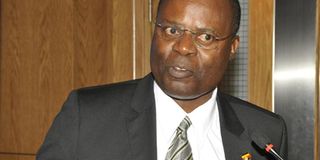Uganda’s forex reserves shrink to Shs9.8 trillion

Dr Louis Kasekende, the Bank of Uganda deputy governor. PHOTO BY MICHAEL KAKUMIRIZI
What you need to know:
Intervention. The Central Bank has sold dollars from the reserves trying to save the depreciating Shilling.
Kampala. Although Uganda’s foreign exchange reserves have reduced to $2.7b (Shs9.8 trillion) from about $3b (Shs10.9 trillion), the time it can cover for future import of goods and services has remained at almost the same level it was in June, Bank of Uganda has revealed.
Foreign exchange reserves are assets held by a central bank or other monetary authority, usually in various reserve currencies, mostly the US dollar and to a lesser extent the euro, the pound sterling, and the Japanese yen, and used to back its liabilities. (wikipedia.org).
Reserve assets comprise monetary gold, foreign exchange assets and other claims in foreign currency.
By June this year, Bank of Uganda’s foreign exchange reserves were around $3 billion (Shs10.9 trillion) covering almost the same level of future imports of goods and services as the case now, but volume has somewhat reduced as result of policy operations.
In Uganda, the Bank of Uganda keeps its foreign exchange reserve in US dollar to safeguard the economy in times of internal or external economic shocks. The US dollar is by far the most important currency in global reserves.
Speaking in Kampala last week, Bank of Uganda deputy governor Louis Kasekende said the level of Uganda’s foreign exchange reserves is sound and above the international requirement by the International Monetary Fund.
“The level of our foreign exchange reserves is $2.7 billion which is equivalent of 4.2 months of future imports of goods and services,” he said.
He said despite the depreciation of the Shilling against the US dollar, the country’s foreign exchange reserves have remained strong to withstand economic shocks.
IMF requirements
The IMF requires central banks to have foreign exchange reserve which can cover three months of future imports of goods and services.
Central banks throughout the world have sometimes cooperate in buying and selling official international reserves to influence the prevailing exchange rates.
The buying and selling can led to changes in reserves level which can be either way high or low.
The quantity of foreign exchange reserves can also change as a central bank implements monetary policy in a particular period of time.
Bank of Uganda buys US dollar to beef up its foreign exchange level while at the same it also sells the US dollar to stem volatilities in the foreign exchange.
Depreciating shilling
Bank of Uganda intervenes in the foreign exchange market in both buy and sell side when there is need.
From August 2014 to August 2015, the Uganda Shilling has depreciated by 42 per cent, however, and Bank of Uganda has come out to intervene on several occasions.
This intervention means the Central Bank sold dollars – from the reserves.
However, the Bank of Uganda research department says the situation is under control.
By close of business on Friday, the official exchange rate closed at Shs3,656.57 per US dollar buying and selling at Shs3,666.57.




